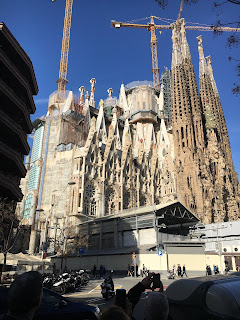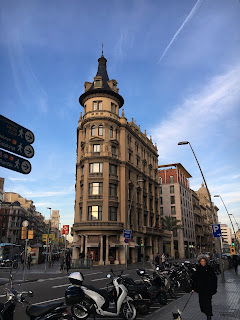Sunday morning was our final day of touring Barcelona, but
included what many would consider the highlight of any trip to the city: The Familia Sagrada (“Sacred Family”) Cathedral. This visit would be followed up with a tour
of Park Gϋell. Both of these sites were designed by the
pride of Barcelona: Antoni Gaudí.
Construction on the Familia Sagrada began in 1882, however
it is still under active construction today and is not expected to be fully
completed until 2032. As we approached
the building and could see the incredible ornate details around the entire outside
and inside of the building it was not difficult to see how the building could
take a century and a half to complete.
In response to the ambitious, long-term undertaking, Gaudi once
responded “My client is not in a hurry.”
Construction continued throughout the rest of Gaudi’s life, and well
beyond, delayed by periods of war and unrest in the area, which resulted in
halts to construction and damage that needed to be repaired at times. Today Gaudi is buried in a crypt within the
cathedral.
Today’s tour was another one that would be a large organized
group tour with 20-30 of my coworkers.
Aimee and I grabbed a quick breakfast and headed towards our tour
bus. As we made our way through the city
towards the cathedral, there were a few moments that when looking out the bus
windows the streets would align with the massive structure in the distance and we
could see a brief unobstructed view of it towering over all of Barcelona.
 |
| Familia Sagrada |
While Gaudi was not assigned to the project until a year
after it’s groundbreaking, the near finished complex is comprised of many
signature characteristics of his works, including non-linear structural forms
and an eclectic mix of gothic design with modern, almost cartoonish
features. At the tops of the many
classic gothic looking spires, are colorful designs that transition from
geometric shapes to arcs and circles with what look like massive cotton balls
of various sizes and asymmetrical shapes.
Many of the outside walls are adorned with 3 dimensional words that are
written in fonts that look like they could have been found spray painted on a
New York subway wall. Upon first looking
at each of the different sections of the cathedral, the initial impression is
one of traditional gothic architecture, however the longer you assess the
design, the details, and the angles, the more you begin to notice the more
peculiar aspects of the design. There
are very few straight lines. Vertical
support columns are not actually vertical, they are at slight angles, and they
branch out like trees at the top.
Finishing touches break away from gothic shapes to the downright trippy.
One of the more fascinating items that we were shown on our
tour was an upside “model” of the cathedral, where Gaudi, in the absence of
Computer Assisted Design, utilized sandbags tied to multiple tethers in order
to determine the angles required to appropriately distribute the weight loads
of the building across its support columns.
He then used the resulting angles to design the columns throughout the
building. In recent decades much of the design and construction
has accelerated due to the advent of computer driven engineering and design,
eliminating the need for such primitive (though impressive) approaches.
While Aimee’s distaste for the style of Gaudi’s work
overshadowed her admiration of the architectural aspects, both of us walked
away incredibly impressed at this magnificent piece of work.
After the cathedral we continued on to another of Gaudi’s
most famous works, Park Gϋell. As compared to
the cathedral, Park Gϋell avoids most all attempts at classical architecture and
to the American visitor comes off as something straight out of a Doctor Seuss
guided tour into Whoville. Ceramic mosaics
covered many of the structures with colorfully flowing and naturally curving
shapes in every direction. We spent
about an hour or so wandering through the park enjoying the fun, though
somewhat psychedelic design of the space.
After our Gaudi focused morning tour, we had a group lunch at
Can Travi Nau on the edges of Barcelona that was in a traditional old Catalan house. Each room had several large round tables and
was furnished like an old country home, and our group was led to one where we were
served some more of the local fare. At
the end of the meal however we were introduced to a traditional wine pitcher
called a porron filled with moscatel wine.
Our waiters brought this out and illustrated to us how to drink out of
it by lifting it over the head and about 6-12 inches from your face, tilting
back your head, and aiming the spout towards your mouth to allow the jet of
wine to pour directly into your mouth.
Each table was then given a porron with the challenge for each person to
pour and swallow simultaneously with the goal of finishing the entire pitcher
in a single pour. As each person failed,
we continued to pass the porron around the table, until it was finally empty.
 |
| Porron |
 |
| Don't Spill! |
On the ride back to the hotel, our tour guide continued to
tell us a bit more about current events in Barcelona. There was an upcoming referendum for
Catalonian independence from Spain. She
had indicated that this was something that had been building for a long time,
and that there were strong indications that this referendum would pass. She
discussed some of the many strong cultural differences between Barcelona and
Spain, not the least of which is the language difference (Catalan vs.
Spanish). She drew our attention to the
many Catalonian flags hung from windows throughout the city, 90% of which
seemed to indicate support for independence. It looked clear that there were
some interesting times ahead for the region.
After arriving back to our hotel, Aimee and I freshened up
and grabbed a taxi to find dinner near Barcelona’s oldest brewery (Moritz) a few
miles away. After checking it out, we ended up changing our mind and landed in
a nondescript Irish pub down the street, and enjoyed a bit of a break from the
Spanish food, which we both decided after several days in Spain wasn’t our
favorite style.
After dinner we began slowly walking in the direction of our hotel, debating weather to get a cab. The weather was a bit warmer than the previous few days, and most importantly dry so we ultimately walked at a leisurely pace the 2-3 miles back to our hotel enjoying the city around us.
Exhausted at this point, we gathered up our belongings and repacked our luggage, as we had a very early departure in the morning.
After dinner we began slowly walking in the direction of our hotel, debating weather to get a cab. The weather was a bit warmer than the previous few days, and most importantly dry so we ultimately walked at a leisurely pace the 2-3 miles back to our hotel enjoying the city around us.
Exhausted at this point, we gathered up our belongings and repacked our luggage, as we had a very early departure in the morning.
DEPARTURE:
The next morning most of our large group (except those that
had extended their stay for personal travel) met several coach busses that took
an exceptionally tired and worn out group of people back to the airport. On top of a hectic schedule for the previous
four days, we had only begun to recover from our initial jet lag. After arriving at the airport however, the
group was met with the unfortunate news of a flight cancellation impacting most
of the 70+ individuals on the trip.
Flights were very quickly re-booked, but scattered many of us to varying
connections throughout the US in order to get us back in a reasonable
time. For Aimee and I, our new flights
resulted in only minimal changes to our final arrival time in Nashville.
When we finally arrived in Nashville, we returned grateful
for the experience and with some great memories, but decided that though we
didn’t dislike it, Barcelona probably wasn’t at the top of the list of places
we’d return to in the near future.












No comments:
Post a Comment